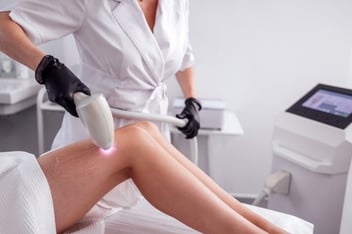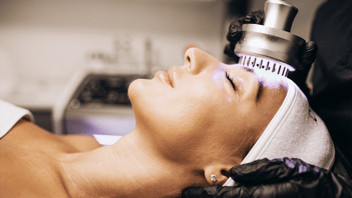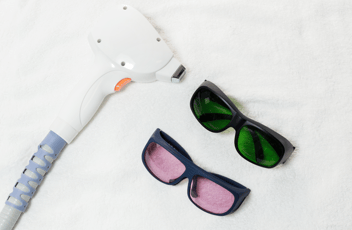
Laser Skin Correcting: Reduce Dark Spots and Hyperpigmentation Through Lasers
Please consult with a board-certified dermatologist before undergoing any skin resurfacing treatments. Recent changes in your skin or certain skin conditions may make such treatments inappropriate or unsafe.
Laser technology continues to evolve, helping individuals address a range of skin concerns, from dark spots and uneven skin tone to hyperpigmentation. Thanks to modern laser correcting treatments, eliminating or reducing these common skin woes is easier and more effective than ever.
The end result is clearer, brighter, and more even skin tone, with minimal downtime and lasting results. With consistency and proper aftercare, patients can continue enjoying smooth, youthful-looking skin for several months after treatment.
If you’re curious about laser correcting treatments for your skin, read on to learn more about this revolutionary treatment, how it works, and why it can be ideal for anyone struggling with dark spots and pigmentation issues.
Understanding Dark Spots and Hyperpigmentation
Dark spots and hyperpigmentation can present themselves in various ways for individuals of all ages and skin types. Often, they appear as darker patches on the skin as a result of an excess production of melanin, the pigment responsible for skin color.
A range of factors can lead to this overproduction, from inflammation and hormonal changes to sun exposure and skin injuries.
By understanding the different types of hyperpigmentation, you can determine the best course of treatment. Let’s take a closer look at the various types of hyperpigmentation to help you make an informed decision for your skin.
Types of Hyperpigmentation
Sunspots

As the name suggests, sunspots are dark patches that develop on the skin after prolonged exposure to ultraviolet (UV) light from the sun. Also called solar lentigines or age spots, they commonly appear on the forehead, hands, nose, and other areas of the skin that experience frequent sun exposure. Sunspots are typically flat, small, and light to dark brown.
Melasma

With its characteristic large, irregularly shaped patches of darkened skin, melasma typically develops on facial areas that see more sun exposure, such as the forehead, cheeks, chin, and upper lip. Hormonal changes accompanying pregnancy, contraceptives, or menopause may also trigger melasma.
Post-Inflammatory Hyperpigmentation (PIH)
 One example of Post-inflammatory hyperpigmentation - Inflamed cyst (Source: DermNet)
One example of Post-inflammatory hyperpigmentation - Inflamed cyst (Source: DermNet)
Individuals may experience post-inflammatory hyperpigmentation (PIH) following inflammation or injury to the skin. Cuts, burns, acne, and insect bites can all be causes of PIH, as pigment cells in the affected area may overproduce melanin and cause the formation of dark spots or patches.
How Laser Treatments Work
With laser correcting, it’s possible to diminish or eliminate the appearance of dark spots, age spots, hyperpigmentation, and uneven skin tone.
Laser correcting treatments can target specific skin concerns while leaving the surrounding skin intact. Using laser energy, laser technology encourages the body to break down skin pigment. In response, the body filters out damaged skin cells and replaces them with new, healthy skin cells.
Benefits of Laser Skin Correcting
Laser correcting offers numerous advantages with its precise technology and effectiveness at addressing skin issues.
Accurate Targeting
Laser technology can pinpoint specific skin concerns, including uneven skin tone, dark spots, and hyperpigmentation. Laser energy penetrates beneath the surface layers of skin, targeting damaged cells without harming surrounding tissue.
Effective Results
Laser skin correcting effectively reduces the appearance of dark spots and hyperpigmentation. By breaking down pigment deposits using laser energy, the treatment stimulates the body's natural healing response. With time, treated areas become lighter, smoother, and more even-toned, resulting in a more radiant complexion.
Customized Treatment Options
At Impressions Face + Body, we’re committed to customizing treatment to suit each individuals’ unique skin types and concerns, from superficial to deeper pigment deposits. With laser correcting, we’re able to tailor sessions to address each patient’s desired outcomes.
Minimal Downtime
Unlike more invasive procedures, laser skin correcting typically involves minimal downtime, allowing patients to resume their daily activities shortly after treatment. Although some patients experience mild swelling, redness, or discomfort, these side effects typically subside within a few days.
Lasting Results
With proper skincare maintenance and sun protection, the results of laser skin correcting can be long-lasting. While individual experiences may vary, many patients enjoy significant improvement in the appearance of dark spots and hyperpigmentation that can last for months to years after treatment. Periodic maintenance treatments can help sustain the results and address new pigmentation concerns.
Types of Lasers for Dark Spot Correction
- ActiveFX (CO2 Laser): Effective for moderate to deep lines and creases caused by aging, sun damage, and acne scars. Provides dramatic, long-lasting results with minimal downtime.
- Clear and Brilliant®: Gently penetrates the skin to create microscopic injuries, triggering the body's healing process. Replaces damaged skin cells with new, healthier ones for a youthful and radiant complexion.
- IPL (Intense Pulsed Light): Uses pulses of light to target vascular and pigmented lesions in the skin. Precisely targets undesirable blood vessels and melanin, leaving surrounding skin unharmed.
- ResurFX™: Non-ablative fractional laser treatment that stimulates collagen production, reducing fine lines and scars to improve overall skin texture. Minimal downtime for revitalized skin.
- Aerolase®: Offers high-powered, gentle treatments for various skin concerns, including acne, rosacea, and hyperpigmentation.
- Lumenis Duet (Hair Removal): Passes a beam of light through the skin to gently warm hair follicles, impeding future hair growth at the treatment site.
Ideal Candidates for Laser Skin Correcting
- Those with dark spots, hyperpigmentation, sunspots, melasma, or post-inflammatory hyperpigmentation
- Patients in good health with no underlying medical conditions that may impede the healing process
- Those with realistic expectations about potential results who understand laser correction may require multiple sessions to achieve optimal results
Factors Affecting Candidacy
- Skin type: The effectiveness and safety of laser treatments can vary depending on the individual's skin type.
- Medical history: Certain medical conditions or a history of skin disorders may affect candidacy for laser skin correcting. Those with a history of keloid scarring, autoimmune disorders, active infections, or skin cancer may not be suitable candidates.
- Current medications and treatments: Some medications and treatments may increase the risk of complications or interfere with the healing process after laser skin correcting. For example, patients may need to discontinue the use of photosensitizing medications, topical retinoids, or recent chemical peels before undergoing laser correcting treatments.
It's essential to discuss all current medications and treatments with your healthcare provider during the consultation process. A comprehensive assessment and medical history review will help ensure the safety and suitability of laser therapy.
Results and Maintenance
Laser skin correcting treatments yield significant improvement in reducing dark spots and hyperpigmentation, resulting in:
- Lightened dark spots
- Improved skin texture
- Enhanced skin tone
To sustain results and prevent pigmentation recurrence:
- Apply SPF 30+ sunscreen daily and reapply every two hours.
- Wear protective clothing and seek shade during peak sun hours.
- Use gentle cleansers and products with vitamin C, retinoids, and niacinamide.
- Schedule periodic follow-up appointments for monitoring and maintenance.
By following these maintenance practices, you can prolong the benefits of laser skin correcting treatments and maintain a clearer, more radiant complexion over time.
Risks and Potential Side Effects
While generally safe and effective, laser skin correcting treatments have potential risks and side effects.
Potential Risks
- Temporary redness, swelling, or discomfort immediately following treatment
- Rare instances of scarring, particularly in individuals with a history of keloid scarring
- Risk of infection if patients do not follow proper post-treatment protocols
Minimizing Risks
- Choose a qualified practitioner with experience in laser treatments.
- Adhere to aftercare instructions, including sun protection and a skincare regimen.
- Communicate openly with your practitioner about your medical history and concerns to tailor treatment and minimize risks.
By taking these precautions, you can minimize risks and maximize the benefits of laser skin correcting treatments for reducing dark spots and hyperpigmentation.
Laser Skin Correcting at Impressions Face + Body
If you’re concerned about hyperpigmentation or dark spots, we invite you to book a consultation at Impressions Face + Body. Our skilled team of professionals specializes in advanced laser treatments to address these skin concerns, helping you achieve clearer, more radiant skin. Ready to say goodbye to uneven skin tone and hello to a brighter complexion? Schedule your consultation today and discover how laser skin correcting can rejuvenate your skin at Impressions Face + Body.
Read On


Lasers: Where, When, and How Do They Improve Appearance?
We all dream of flawless, radiant skin that looks as though it belongs on the cover of a...

Remove Unwanted Hair: Benefits of Laser Hair Removal
Out with the old and in with the new—traditional hair removal methods like shaving, waxing, and...

